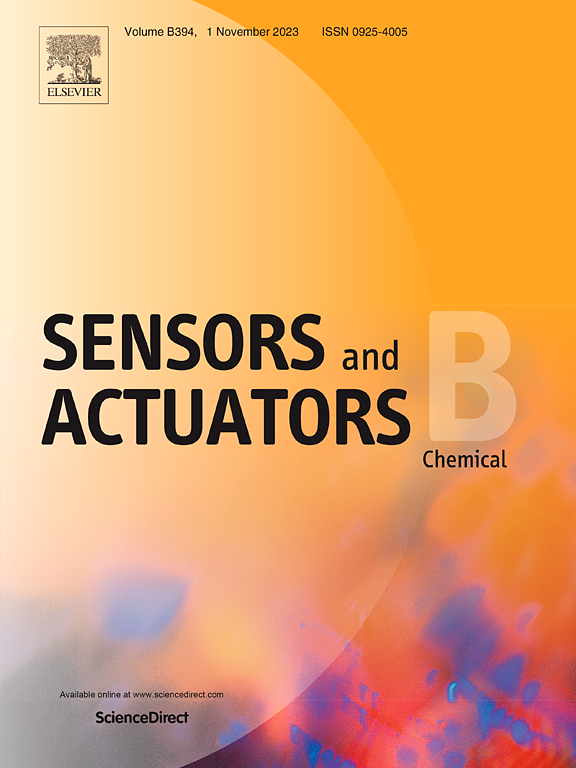Photoelectrochemical sensing Hela cell mitochondria released superoxide anion using a novel heterojunction formed by dispersing a wheel-shaped polyoxometalate on α-Fe2O3 nanoarray
IF 8
1区 化学
Q1 CHEMISTRY, ANALYTICAL
引用次数: 0
Abstract
An ultra-sensitive photoelectrochemical (PEC) sensor was developed by immobilizing negatively charged wheel-shaped polyoxometalate (Co16Mo16P24) clusters onto positively charged α-Fe2O3 nanoarray modified F-doped Tin Oxide glass (α-Fe2O3NRs|FTO) through electrostatic adsorption. α-Fe2O3NRs|FTO has a large specific surface area to well disperse {Co16Mo16P24} clusters with excellent charge transfer behavior and PEC properties. {Co16Mo16P24} and α-Fe2O3NRs have been verified to be perfectly matched in energy levels, which form a high-efficiency heterojunction for promoting an effective separation of photogenerated electron-hole couples. Based on that, the PEC sensor exhibits a wide linear range from 0.005 nM to 5000 nM for hydrogen peroxide (H2O2) detection, with a sensitivity of 12.51 μA·nM-1, a detection limit of 0.093 nM, an excellent selectivity and long-term stability. Owing to the rapid conversion of superoxide radicals (O2•⁻) to H2O2, the sensor can therefore indirectly measure O2•⁻ derived from the electron leakage in mitochondrial electron transfer chain (ETC) by detecting H2O2 levels. To achieve a more reliable measurement, four inhibitors—rotenone, 2-monoacyltrifluoroacetone, antimycin A, and paclitaxel were utilized to induce the release of O2•⁻ from complexes I, II, III and IV in Hela cell mitochondria, respectively. By comparing the photocurrent changes caused by different inhibitors, we identify complex Ⅰ as the mostly likely site of electron leakage, which may provide meaningful information for the diagnosis of some oxidative stress diseases.

利用在α-Fe2O3纳米阵列上分散轮状多金属氧酸盐形成的异质结,光电传感Hela细胞线粒体释放超氧阴离子
采用静电吸附法将带负电荷的轮状多金属氧酸盐(Co16Mo16P24)团簇固定在带正电荷的α-Fe2O3纳米阵列修饰的掺f氧化锡玻璃(α-Fe2O3NRs|FTO)上,研制了一种超灵敏的光电化学(PEC)传感器。α-Fe2O3NRs|FTO具有较大的比表面积,可以很好地分散{Co16Mo16P24}簇,具有优异的电荷转移行为和PEC性能。{Co16Mo16P24}和α-Fe2O3NRs在能级上完全匹配,形成了高效的异质结,促进了光生电子-空穴对的有效分离。在此基础上,PEC传感器对过氧化氢(H2O2)的检测具有0.005 ~ 5000 nM的宽线性范围,灵敏度为12.51 μA·nM-1,检出限为0.093 nM,具有良好的选择性和长期稳定性。由于超氧自由基(O2•⁻)迅速转化为H2O2,因此传感器可以通过检测H2O2水平间接测量O2•毒血症(由线粒体电子传递链(ETC)中的电子泄漏产生)。为了获得更可靠的测量,使用四种抑制剂-鱼藤酮,2-单酰基三氟丙酮,抗霉素a和紫杉醇分别诱导Hela细胞线粒体中的复合物I, II, III和IV释放O2•毒血症。通过比较不同抑制剂引起的光电流变化,我们确定复合物Ⅰ是最可能的电子泄漏位点,这可能为一些氧化应激疾病的诊断提供有意义的信息。
本文章由计算机程序翻译,如有差异,请以英文原文为准。
求助全文
约1分钟内获得全文
求助全文
来源期刊

Sensors and Actuators B: Chemical
工程技术-电化学
CiteScore
14.60
自引率
11.90%
发文量
1776
审稿时长
3.2 months
期刊介绍:
Sensors & Actuators, B: Chemical is an international journal focused on the research and development of chemical transducers. It covers chemical sensors and biosensors, chemical actuators, and analytical microsystems. The journal is interdisciplinary, aiming to publish original works showcasing substantial advancements beyond the current state of the art in these fields, with practical applicability to solving meaningful analytical problems. Review articles are accepted by invitation from an Editor of the journal.
 求助内容:
求助内容: 应助结果提醒方式:
应助结果提醒方式:


